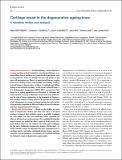| dc.contributor.author | Brittberg, Mats | en_US |
| dc.contributor.author | Gomoll, Andreas H | en_US |
| dc.contributor.author | Canseco, José A | en_US |
| dc.contributor.author | Far, Jack | en_US |
| dc.contributor.author | Lind, Martin | en_US |
| dc.contributor.author | Hui, James | en_US |
| dc.date.accessioned | 2017-05-01T19:26:35Z | |
| dc.date.issued | 2016 | en_US |
| dc.identifier.citation | Brittberg, Mats, Andreas H Gomoll, José A Canseco, Jack Far, Martin Lind, and James Hui. 2016. “Cartilage repair in the degenerative ageing knee: A narrative review and analysis.” Acta Orthopaedica 87 (Suppl 363): 26-38. doi:10.1080/17453674.2016.1265877. http://dx.doi.org/10.1080/17453674.2016.1265877. | en |
| dc.identifier.issn | | en |
| dc.identifier.uri | http://nrs.harvard.edu/urn-3:HUL.InstRepos:32630434 | |
| dc.description.abstract | Background and purpose Cartilage damage can develop due to trauma, resulting in focal chondral or osteochondral defects, or as more diffuse loss of cartilage in a generalized organ disease such as osteoarthritis. A loss of cartilage function and quality is also seen with increasing age. There is a spectrum of diseases ranging from focal cartilage defects with healthy surrounding cartilage to focal lesions in degenerative cartilage, to multiple and diffuse lesions in osteoarthritic cartilage. At the recent Aarhus Regenerative Orthopaedics Symposium (AROS) 2015, regenerative challenges in an ageing population were discussed by clinicians and basic scientists. A group of clinicians was given the task of discussing the role of tissue engineering in the treatment of degenerative cartilage lesions in ageing patients. We present the outcomes of our discussions on current treatment options for such lesions, with particular emphasis on different biological repair techniques and their supporting level of evidence. Results and interpretation Based on the studies on treatment of degenerative lesions and early OA, there is low-level evidence to suggest that cartilage repair is a possible treatment for such lesions, but there are conflicting results regarding the effect of advanced age on the outcome. We concluded that further improvements are needed for direct repair of focal, purely traumatic defects before we can routinely use such repair techniques for the more challenging degenerative lesions. Furthermore, we need to identify trigger mechanisms that start generalized loss of cartilage matrix, and induce subchondral bone changes and concomitant synovial pathology, to maximize our treatment methods for biological repair in degenerative ageing joints. | en |
| dc.language.iso | en_US | en |
| dc.publisher | Taylor & Francis | en |
| dc.relation.isversionof | doi:10.1080/17453674.2016.1265877 | en |
| dc.relation.hasversion | http://www.ncbi.nlm.nih.gov/pmc/articles/PMC5389429/pdf/ | en |
| dash.license | LAA | en_US |
| dc.title | Cartilage repair in the degenerative ageing knee: A narrative review and analysis | en |
| dc.type | Journal Article | en_US |
| dc.description.version | Version of Record | en |
| dc.relation.journal | Acta Orthopaedica | en |
| dash.depositing.author | Gomoll, Andreas H | en_US |
| dc.date.available | 2017-05-01T19:26:35Z | |
| dc.identifier.doi | 10.1080/17453674.2016.1265877 | * |
| dash.contributor.affiliated | Gomoll, Andreas H. | |


